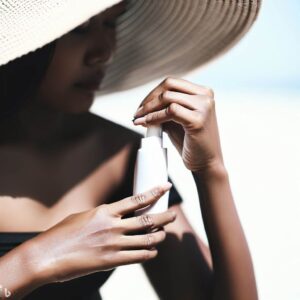The sun’s warm hug can be welcoming, yet its bright (UV) beams, when left ignored, can antagonistically affect your skin. Repairing Sun-Damaged Skin is a typical worry that influences people, everything being equal. Be that as it may, fret not, for this exhaustive aide is here to enlighten the way to better, brilliant skin. Welcome to “A definitive Manual for Fixing Sun-Harmed Skin: Tips and Methods.” All through this excursion, we will dig into the science behind sun harm, investigate a range of counteraction and fix procedures, and enable you with the information expected to reestablish and defend your skin’s normal excellence.
Along these lines, how about we leave on this journey toward accomplishing sun-kissed skin that emanates with essentialness, outfitted with tips and procedures to restore and safeguard your skin successfully – your body’s most valuable organ.
HOW UV RAYS AFFECT THE SKIN?
UV beams unfavorably affect the skin, going from untimely maturing and restorative issues like kinks and dim spots to additional extreme outcomes like an expanded gamble of skin malignant growth. Safeguarding the skin from UV openness through sunscreen, defensive attire, and sun aversion is significant for keeping up with skin wellbeing and appearance.
Repairing Sun-Damaged Skin SKIN FROM FURTHER DAMAGE?
Sunscreen and sun protection are essential tools in keeping further harm from the hurtful impacts of bright (UV) radiation. They give a significant guard against the destructive impacts of UV radiation, decreasing the gamble of burn from the sun, skin disease, untimely maturing, and other skin-related issues while assisting with keeping up with your skin’s general wellbeing and appearance.
Selecting the right sunscreen and choosing the appropriate SPF (Sun Protection Factor) level is essential for effective sun protection. Here’s a guide to help you make the best choices to get tention free of Repairing Sun-Damaged Skin:
1. Broad-Spectrum Protection:
- Look for a sunscreen labeled as “broad-spectrum.” This indicates that it provides protection against both UVA and UVB rays. UVA rays contribute to premature aging, while UVB rays are responsible for sunburn and skin cancer.
2. SPF Level:
- SPF measures protection against UVB rays, which cause sunburn. Choose an SPF level that suits your needs:
- SPF 15: Provides basic protection for everyday activities.
- SPF 30: Offers moderate protection for most outdoor activities.
- SPF 50 or higher: Ideal for extended sun exposure, outdoor sports, or fair-skinned individuals.
Repairing Sun-Damaged Skin is essential for maintaining its health and preventing damage. Here are some practical tips for safeguarding your skin from the sun:
- Use Sunscreen:
- Apply a broad-spectrum sunscreen with SPF 30 or higher generously to all exposed skin areas to get rid of Repairing Sun-Damaged Skin.
- Don’t forget often-missed areas like the ears, neck, lips, and the back of your hands.
- Reapply sunscreen every two hours, or more frequently if swimming or sweating.
- Seek Shade:
- Whenever possible, stay in the shade, especially during peak sun hours (10 a.m. to 4 p.m.).
- Shade provides natural protection and reduces direct UV exposure.
- Wear Protective Clothing:
- Opt for clothing that covers your arms and legs.
- Choose tightly woven, dark-colored fabrics for better sun protection.
- Wide-brimmed hats can shade your face, neck, and ears.
- Sunglasses with UV protection shield your eyes and the delicate skin around them.
- Use Umbrellas and Sun Shelters:
- When at the beach or in open areas, set up umbrellas or pop-up sun shelters for additional shade.
- Stay Hydrated:
- Proper hydration helps keep your skin healthy and minimizes the risk of heat-related skin issues.
- Drink plenty of water when you’re out in the sun to stay hydrated to avoid Repairing Sun-Damaged Skin.
- Avoid Tanning Beds:
- Tanning beds emit harmful UV radiation that can damage your skin and increase skin cancer risk.
- Plan Outdoor Activities Wisely:
- Schedule outdoor activities earlier in the morning or later in the afternoon to avoid midday sun.
- Consider indoor or shaded alternatives for activities during peak sun hours to avoid Repairing Sun-Damaged Skin.
- Use Sun-Protective Swimwear:
- Swimwear with UPF (Ultraviolet Protection Factor) offers additional sun protection while swimming.
- Apply Lip Balm with SPF:
- Protect your lips by using a lip balm or lipstick with SPF to prevent sunburn and chapping.
- Stay Informed About UV Index:
- Check the UV Index for your location before heading outdoors. Adjust your sun protection measures based on the index’s intensity to avoid Repairing Sun-Damaged Skin.
- Monitor Moles and Skin Changes:
- Regularly examine your skin for any unusual moles, growths, or changes in color or size. Consult a dermatologist if you notice any concerning changes.
- Wear Sunscreen Year-Round:
- UV rays are present even on cloudy days and during winter months. Make sunscreen a daily habit.
- Teach Sun Safety to Children:
- Educate children about sun safety practices from a young age and ensure they use sunscreen, wear protective clothing, and seek shade.
- Consider Window Film or Tint:
- Apply window film or tint to car and home windows to block harmful UV rays to avoid Repairing Sun-Damaged Skin.
- Regular Skin Check-Ups:
- Schedule regular skin check-ups with a dermatologist, especially if you have a family history of skin cancer or other risk factors.
By following these practical tips, you can effectively safeguard your skin from the sun’s harmful UV radiation and reduce the risk of sunburn, premature aging, and skin cancer. Remember that consistent sun protection is a key part of maintaining skin health.



